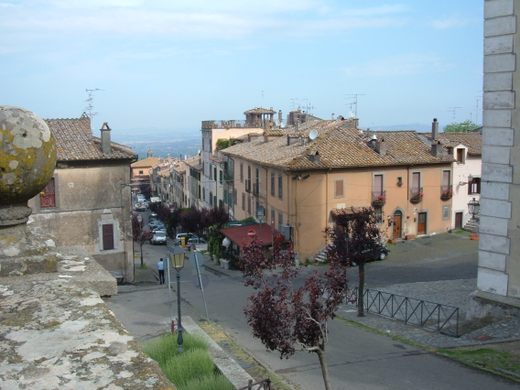San Martino al Cimino
This medieval Italian village was transformed into an architectural marvel by the famous "Papessa" Donna Olimpia.
Built atop medieval ruins on the slopes of the Cimini Mountains, the village of San Martino al Cimino preserves rare and remarkable examples of Baroque-era architecture and urban planning, conceived in the 16th century by the influential and (in)famous Olimpia Maidalchini Pamphilj, one of the most powerful women of Papal Rome.
Located along the Via Francigena pilgrimage road to Rome, the village was originally settled by the Cistercian Order, who built an abbey and a monastic complex there in the 11th and 12th centuries, which now lie in ruins. The complex was abandoned in the 1500s and the land was given to Olimpia Maidalchini Pamphilj—better known as simply “Donna Olimpia”—by her brother-in-law Pope Innocent X. He also awarded her the title of “Princess of San Martino al Cimino.”
Donna Olimpia was a famous and powerful woman in Rome at the time, and was often the target of jeering comments and the satires of the “talking statues” of Rome (stone figures that served as a way for the public to voice criticism under Papal control). This derision was a reflection of the strong influence Donna Olimpia held over her brother-in-law, which earned her another nickname: the “Papessa,” roughly translating to “Lady Pope.”
Nevertheless, the Princess of San Martino al Cimino devoted much of her enormous wealth and ambition into her village. She enlisted renowned Italian architects and artists like Francesco Borromini, Marcantonio De Rossi, and Gian Lorenzo Bernini to design a fiefdom that would be both impressive and functional.
The resulting town centers around the wonderful Gothic-Cistercian church, framed by two bell towers designed by Borromini. Donna Olimpia herself, who died of plague in 1657, is buried in the church, and an elaborate gravestone with a Memento Mori skeleton adorns the spot. Another landmark of the village is the Palazzo Doria Pamphilj (Doria Pamphilj Palace) next to the church, where ruins of the medieval monastic complex are still visible.
The palace is only occasionally open to the public but it is a remarkable example of Baroque architecture, with its wooden gilded ceilings, frieze frescoes, and spiral staircase. One feature stands out: Donna Olimpia had the architects design her room with a system of pulleys that could lower the ceiling in winter to make the space smaller and easier to heat.
Donna Olimpia is also responsible for the town’s original layout. The village is surrounded by medieval walls that are only accessible from two gates—the lower of which, designed by Borromini, is crowned by the Pamphilj insignia. She also instructed Borromini and De Rossi to design housing in regular patterns along the city walls, which was granted to the laborers working on the Doria Pamphilj Palace. This early example of city planning is rather unique, and it’s quite evident when you walk through the streets of this exceptional old village.
Know Before You Go
San Martino al Cimino is located near Viterbo, a short drive away from Vico Lake, in the Cimini Mountains region of Lazio. The map coordinates above point to the Cistercian Abbey (Abbazia Cistercense) of San Martino al Cimino at the center of town. The palace is right next to the abbey, and ruins of the medieval-era monastery can be seen between the two buildings.

























Follow us on Twitter to get the latest on the world's hidden wonders.
Like us on Facebook to get the latest on the world's hidden wonders.
Follow us on Twitter Like us on Facebook